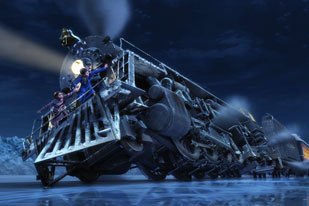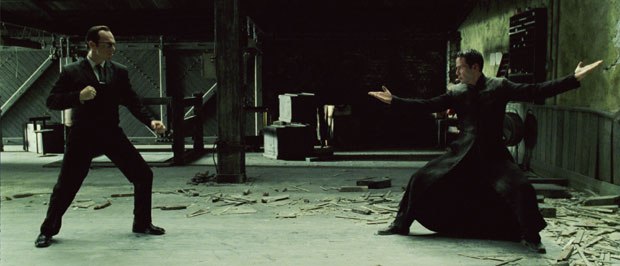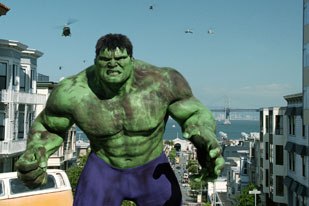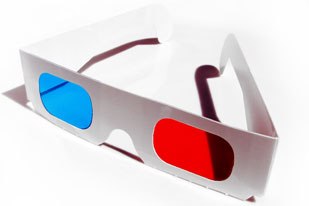Christopher Panzner ponders the future of 3D and visual effects in creating immersive worlds beyond what can be imagined today.

Exactly when does vfx become animation? Rotoscopy? Mocap? Virtual reality? Has it already happened with Polar Express? © 2004 by Warner Bros. Ent. Inc.
Animation has become more like live action and live action has become more like animation. Anyone said that to you lately? Havent noticed? Seen any comicbook movies lately? How about documentaries? How about Koyaanisqatsi? Powaqqatsi? Oh, right that was a while ago. In any event, more than 50% of live action these days comprises vfx/animation.
Just exactly when does vfx become animation? Rotoscopy? Mocap? Virtual reality? Has it already happened with Polar Express? What about rides? Holography? How blurred have the lines become?
Is physics the line in the sand (parallel universes, superpowers, gravity, etc.) between the real and the imaginary? Or is it psychological magic vs. science?
Do programmers ask themselves these kinds of questions?
Princess Leias Hologram
As recently as last year, a significant little news blurb announced that a Japanese company, Optware Corp., had developed the Collinear Holographic Data Storage System, the worlds first recording and play back of digital movies on a holographic recording disc with a reflective layer. Do you realize research scientists are talking about projecting holograms to large audiences through crystals? Its reportedly going to be, ahem, difficult, but its presently in the realm of the discussable?
Are these guys a card shy of a holodeck?
Dont tell that to the guys at IMAX 3D.
And do I need to get my chapka blocked or are animation and visual effects merging into a hybrid 3D form? Evolving as they have for hundreds of years, now, from early trompe loeil paintings to the stereoscopic photography fad of the mid 1850s (when more than a million homes owned a device to view the more than 100,000 clichés commercially available) to 1895s The Execution of Mary Queen of Scots to French magician George Méliès films to the first rides at the 1900 Paris Fair (a 45-minute simulated 14-day rail journey between Moscow and Peking on the Trans-Siberian Railway, a simulated cruise from Nice to Constantinople and a simulated hot air balloon ride that featured a filmed panorama of Paris) to 1925s stop-motion The Lost World to the Acme-Dunn Special Effects Optical Printer to Scopitone, the Experience Theater, the Sensorama Simulator and the Telesphere Mask of the 1950s to The 1964 Worlds Fair and The G.E. Carousel Of Progress at Disneyland and now Disney World in Florida and, and, and films like The Ten Commandments, 2001: A Space Odyssey, the disaster films of the 1970s and the dawn of the Modern Age with Star Wars, Close Encounters, the first full-CGI character, a medieval knight in 1985s Young Sherlock Holmes, then Terminator 2, Jurassic Park, Toy Story, the first entirely 3D movie, the 450 vfx shots extravaganza Titanic, Bullet Time, The Super Burly Brawl, The Freeway Chase, Neo flying.

Is The Matrix part of the merging of animation and vfx into a hybrid 3D form? © 2003 Warner Bros. Ent. U.S., Canada, Bahamas & Bermuda. © 2003 Village Roadshow Films (BVI) Ltd. all other territories (all rights reserved
Once more, this time without feeling and not necessarily in order: Muybridges (trivia Muybridge murdered his wifes lover in 1874 judged justifiable homicide) zoopraxiscope, make-up, substitution shots, pyrotechnics, flying with wires, hanging miniatures, mattes, animatronics, rear projection, stop-motion, mocap, mocon, virtual theme park rides, VR, simulators, thrill rides, augmented reality, non-immersive (desktop) systems and semi-immersive projection systems, bots, automated self representations. Ted Kaczynski. Cyber I did not have sexual relations with that woman. The Virtual Workplace. Nanocomputing, holocomputing, biological and quantum computing.
Well, it seems the discussion is less about light sabres (vfx reputedly done by a South Korean animation studio for George Lucas) than just what exactly Princess Leias message was really about. Last week at ShoWest, stumping for Texas Instruments DLP Cinema projectors and digital 3D projection, James Cameron said, Im a man on a mission when it comes to 3D. I will be making all of my films in 3D in the future Soon audiences will associate 3D with the highest level of visual content in the market, and seek out that premium experience
Light Amplification by Stimulated Emission of Radiation
The success of a 1952 low-budget live-action 3D adventure feature, Bwana Devil go figure sparked a run on stereoscopic cinema, as it was known then. Hollywood has long been a lover of gadgetry and science. The Academy of Motion Picture Arts and Sciences. I mean, scratch and sniff films? Jaws 3D was one of the only movies I have ever walked out on. Bored or scared, you ask? Bored silly. But the effect worked. (Sort of like when I saw Burnt Offerings in high school one weekend and then went back a second weekend and they showed the reels out of sequence.)
Will the Jamaican flag colors of holography (from the Greek holos, whole, and gramma, meaning message) finally merge live, animation and visual effects? And what we will bring from cyberspace into our space? That is the question because cyberspace is where the rules are being established, as we speak, for the physics of virtual cinema.
In an online article called Mudding: Social Phenomena in Text-Based Virtual Realities by Pavel Curtis, I found this description of a MUD (Multi-User Dungeon or Multi-User Dimension): a network-accessible, multi-participant, user-extensible virtual reality whose user interface is entirely textual. Participants (usually called players) have the appearance of being situated in an artificially-constructed place that also contains those other players who are connected at the same time. Players can communicate easily with each other in realtime. This virtual gathering place has many of the social attributes of other places, and many of the usual social mechanisms operate there. Certain attributes of this virtual place, however, tend to have significant effects on social phenomena, leading to new mechanisms and modes of behavior not usually seen IRL (in real life.) Online gaming, videoconferencing, telecommuting, VR goggles/gloves, etc. are the warm up to commercial, industrial telepresence over here. The blending of inner and outer space. As well as individual, customized storytelling and uncustomary role-playing. Cyber-psychiatry, even.
The Matrix triptych was the start of preparing our collective psyche for the leap to Ubermensch on the live side and Batman, Spider-Man, The Hulk, X-Men and scores of other films have been preparing us on the other, cartoon side. (You know, in most countries in the world, most comicbooks are religious? And, believe me, the Marvel pantheon, for example, says no less about the human condition and aspirations than The Mahabharata.)
Polar Express, Sky Captain, the latest Star Wars trilogy, Harry Potter, The Matrix, The Lord of the Rings its amazing how many of these movies have become sequels. Franchises. Fables. Has Hollywood found the Yellow Brick Road? What would Joseph Campbell say?
Somewhere, over the rainbow, is holography. But, for the moment, integral stereograms, the only type of holography to feature conventional movie technology and moving images, are where we left off the discussion in the Mainstream on holography. Digital vfx pioneer and author, Isaac Kerlow (The Art of 3D Computer Animation and Effects), says I have followed holography since its early days, and I am still waiting to see an example that delivers on all of the early promises. I think that holography is a great idea and a cool gadget, but it does not have the resolution or dynamic range to handle high quality animation or visual effects. The desire for virtainment (virtual reality entertainment), however, will drive cyberspace into the waiting arms of technology and consumerism, the garden variety and the intellectual kind.

The Hulk and scores of other films have been preparing us on the other cartoon side. © 2003 Universal Pictures. All rights reserved. Photo credit: Industrial Light & Magic.
But, for the moment, we venture into Cyber World. What happens when it comes to us? All the avatars that I have experienced are clunky representations of reality and real people. I think that the goal of animation of visual effects is to enrich reality itself and human contact, not to replace them adds Kerlow. ... Talking to todays avatars can be fun but it certainly hasnt changed my perception of reality. Will confronting a real avatar in 3D or, better yet, in 4D (reality) change my perception of reality? Because even 3D is a 2D effect until you can touch it, feel it... live it, believe it. And its personal.
After that, as they say in Ireland, Bobs your uncle. Meaning, its a done deal.
Youre in My Cyberspace, Mon
Is 3D an effect, an environment, a place...? Check out the interactive free-space display on io2technology.com. Augmented reality which, in my opinion, would be better called annotated reality (heads up display, for example) has already subtly making the leap in the form of instant replay, multiple camera views in gaming, satellite positioning, etc. The distinction between player, spectator, author, actor and director will melt into one soon. Content creation is taking more and more the form of non-linear storytelling, too. A mocap shoot looks exceedingly like mecha Steampunk. Kerlow adds, I think that it can be very powerful when used appropriately and creatively. Mocap is clearly not traditional keyframe character animation, no arguments there, but it can deliver great animation. Look at the Gollum (a combination of mocap and keyframe) or some of those amazing videogame animation cut sequences.
Today cyberspace is about Internet shopping, chat rooms, videogames, blogs, MUDS, HDTV, IMAX, scientific visualization, downloads, psychotherapy, physical therapy. Money, pornography, violence, politics. Tomorrow is about The Cyborg.
In the not so distant future, well all be wearing electronic body gloves to live out the dreams money can and cant buy. Because you know its going to cost something, right? And shortly after that our nervous systems are going to be hardwired to our make-believe lives where well see, smell, taste and touch the virtual and our poor, addled brains will get used to the idea of flying, morphing, sex changes, confronting our demons and angels, etc And gambling and losing, without the physical consequences. Our collective, assumed consensus of reality will become elastic.
Ah, liberation.
We are definitely seeing some new art forms emerge as a result of the merging of different media continues Kerlow. Take, for example, videogames; many of them are compelling enough for teenagers and young adults to submerge themselves playing dozens of hours every week. Another example, interactive cinema the idea that the spectator can participate and interact with the movie is pretty cool, and we are starting to see some promising examples of that. Many of these art forms are still in the early stages, but I believe the best is yet to come.
British/Hungarian scientist Dennis Gabor, inventor of the laser, developed holography in 1947. He later said, inventive minds ought to consider social inventions as their first priority. He wrote three books expressing this viewpoint, Inventing the Future (1963), Innovations (1970) and The Mature Society (1972). He also said, Though I still have much unfinished technological work on my hands, I consider this as my first priority in my remaining years. Tielhard de Chardins noosphere? An intrinsically good spiritual state or collective consciousness toward which humanity is evolving?

Get out those red and green glasses and plug em in!
Get out those red and green glasses and plug em in! A lot going on at home, too in the multimedia theatre we used to call The Living Room. There are more than 200 3D movies on film. Watch NASA, fashion designers, commercials, music no, wait, youre already doing that. Always on the first wave of bleedin technology.
Animation has become more like live action and live action has become more like animation.
New Vocabulary Alert: nauseogenic (stimulation sickness).
Are we there yet?
Chris Panzner has split the last 25 years doing TV, animation and films. His father, an architect, once said to him, Someday, son, none of this will be yours. He recently created writing company Power Lines and production/distribution company Eye & Ear.








